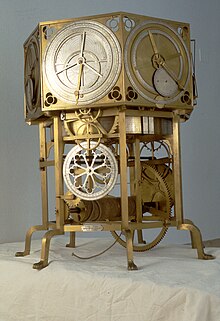
Back Астрарыум Byelorussian Astrarium Catalan Astrario Spanish Astrarium French Աստղացուցարան Armenian Астрариум Macedonian Astrarium Malay Астрариум Russian Astraryum Turkish Астраріум Ukrainian

An astrarium, also called a planetarium, is a medieval astronomical clock made in the 14th century by Italian engineer and astronomer Giovanni Dondi dell'Orologio. The Astrarium was modeled after the solar system and, in addition to counting time and representing calendar dates and holidays, showed how the planets moved around the celestial sphere in one timepiece.[1] This was its main task, in comparison with the astronomical clock, the main task of which is the actual reading of time. A complex mechanism, it combined the functions of a modern planetarium, clock, and calendar into a singular constructive device. Devices that perform this function were known to have been created prior to the design of Dondi, though relatively little is known about them. It is occasionally erroneously claimed by the details of some sources that the Astrarium was the first mechanical device showing the movements of the planets.[2][3]
- ^ Museo Galileo — Multimedia — Mechanical clocks
- ^ Harris, Judith. (2009-03-22). "Celebrating Galileo in Florence — California Literary Review". California Literary Review.
- ^ "Image of de dondi's 'astrarium', the world's first astronomical clock, 1364". Inventory No.: 1974-0386. Science & Society Picture Library. Retrieved 2023-02-22.